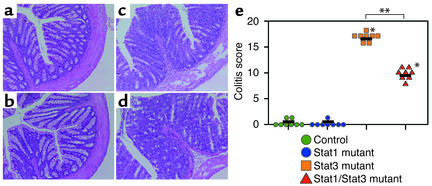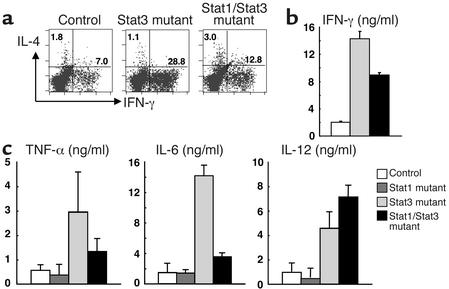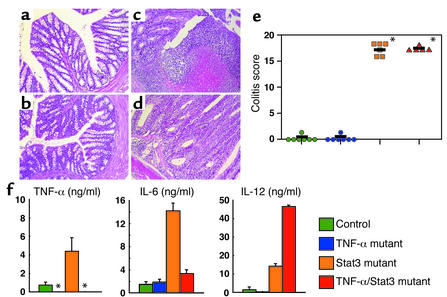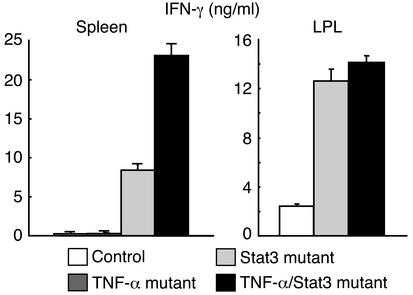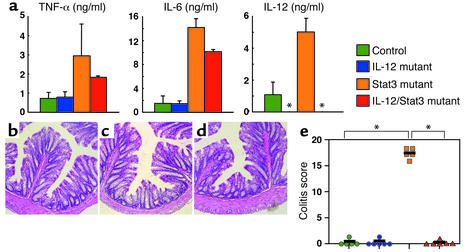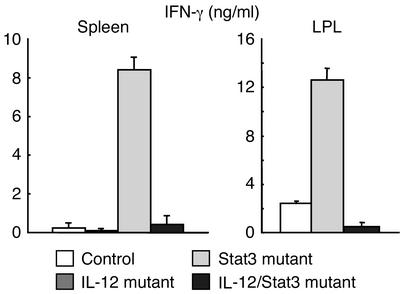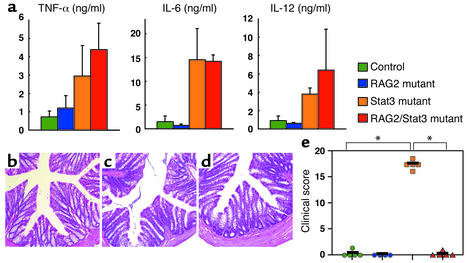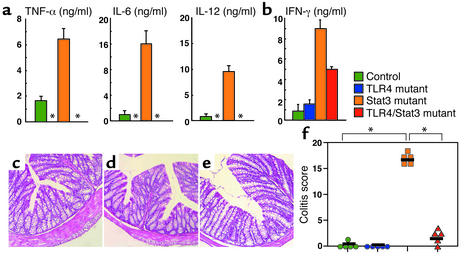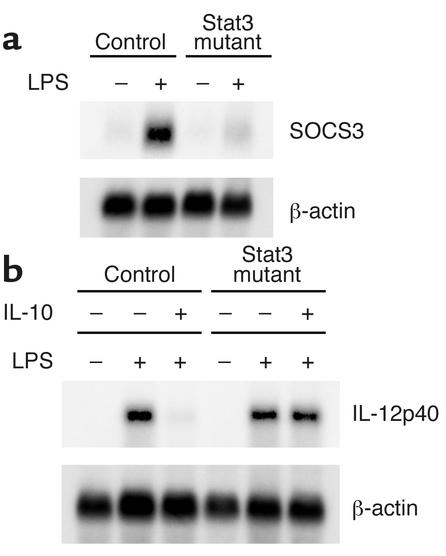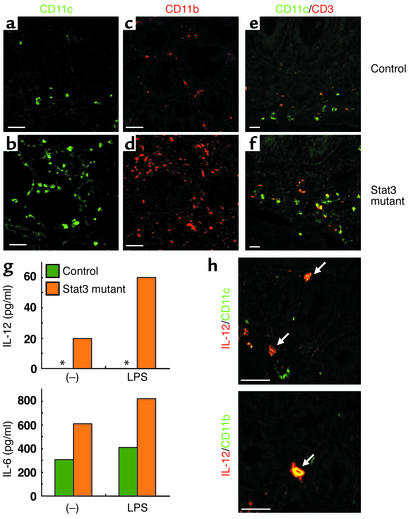Abstract
Stat3 plays an essential role in IL-10 signaling pathways. A myeloid cell-specific deletion of Stat3 resulted in inflammatory cytokine production and development of chronic enterocolitis with enhanced Th1 responses in mice. In this study, we analyzed the mechanism by which a Stat3 deficiency in myeloid cells led to the induction of chronic enterocolitis in vivo. Even in the absence of Stat1, which is essential for IFN-γ signaling pathways, Stat3 mutant mice developed chronic enterocolitis. TNF-α/Stat3 double-mutant mice developed severe chronic enterocolitis with enhanced Th1 cell development. IL-12p40/Stat3 double-mutant mice, however, showed normal Th1 responses and no inflammatory change in the colon. RAG2/Stat3 double-mutant mice did not develop enterocolitis, either. These findings indicate that overproduction of IL-12p40, which induces potent Th1 responses, is essential for the development of chronic enterocolitis in Stat3 mutant mice. Furthermore, enterocolitis was significantly improved and IFN-γ production by T cells was reduced in TLR4/Stat3 double-mutant mice, indicating that TLR4-mediated recognition of microbial components triggers aberrant IL-12p40 production by myeloid cells, leading to the development of enterocolitis. Thus, this study clearly established a sequential innate and acquired immune mechanism for the development of Th1-dependent enterocolitis.
Introduction
Human inflammatory bowel diseases (IBD) including Crohn diseases and ulcerative colitis are chronic immune-mediated disorders whose pathogenesis and etiology are largely unknown (1). A number of gene-manipulated murine models of colitis have been developed. These include IL-10–deficient, T cell receptor-α–deficient, Gαi2–deficient, Stat4-transgenic, and T-bet-transgenic mice (2–5). Experimentally induced models of colitis have also been established by reconstituting immunocompromised mice with CD4+ CD45RBhigh T cells. All of these models are used in attempts to elucidate the pathogenesis of IBD. As a result, it has been proposed that an exaggerated bias toward Th1 or Th2 polarization in the mucosal immune system is a key factor in the pathogenesis of colitis (6, 7).
In IL-10–deficient mice, CD4+ T cells residing in the lamina propria region of intestinal tract preferentially produced IFN-γ (8). Immunocompromised mice transferred with T cells from IL-10–deficient mice developed colitis with skewed Th1 responses (9). Furthermore, treatment with anti–IFN-γ Ab significantly delayed the onset of the disease and reduced the severity of colitis in young IL-10–deficient mice (8). Treatment of anti-IL-12 Ab prevented the development of the disease in young IL-10–deficient, but not in aged IL-10–deficient, mice (7, 10). Thus, the involvement of Th1 cells has become clear in the pathogenesis of early phase of colitis in IL-10–deficient mice. IL-10 is a well-known regulatory cytokine, which can provide positive and negative signals on a variety of immune cells including B cells, T cells, NK cells, mast cells, and myeloid cells (11). Additionally, IL-10 has recently been shown to play an important role in the differentiation and function of regulatory T cells, which possess a capacity to inhibit harmful immune disorders including chronic colitis (12, 13). Although it is now clear that IL-10 plays an essential role in the negative regulation of inflammatory responses in the intestine, the mechanism by which IL-10 exerts the anti-inflammatory responses remains unclear.
The STAT family of transcription factors, consisting of seven members, is involved in cytokine signaling. The knockout of each member of the STAT family in mice resulted in impaired responses to corresponding cytokines, demonstrating that STAT proteins have essential roles in cytokine-mediated biological responses (14, 15). Unlike the knockout of all other STAT family members, the knockout of Stat3 resulted in early death in embryogenesis (16). Therefore, Stat3 has been deleted in a cell- or tissue-specific manner by the Cre-loxP recombination system in order to examine biological and functional roles of the transcription factor in vivo (17–19). For example, mice lacking Stat3 in myeloid cells such as macrophages, neutrophils, and dendritic cells developed chronic enterocolitis and showed exaggerated Th1 responses (20). The immunological and histological analysis revealed very similar disease development in the intestinal tract of IL-10–deficient mice. Macrophages from the Stat3 mutant mice did not show any anti-inflammatory responses mediated by IL-10 and produced increased levels of inflammatory cytokines in response to bacterial LPS, demonstrating that Stat3 is essential for the IL-10–mediated signaling pathways in myeloid cells (20). This study also indicated that myeloid cells, including macrophages and dendritic cells, are major targets for IL-10 exhibiting anti-inflammatory responses in vivo, and the abnormal activation of myeloid cells is involved in the pathogenesis of chronic colitis in mice. It remains elusive, however, how the abnormal activation of myeloid cells leads to the development of colitis in vivo.
In this study, we examined the in vivo mechanism by which activated myeloid cells in the absence of IL-10 signaling induce chronic colitis using Stat3 mutant mice with additional deleted alleles, such as Stat1, TNF-α, IL-12p40, RAG2, and Toll-like receptor 4 (TLR4).
Methods
Mice.
Stat3 mutant (LysMcre; Stat3flox/flox) mice on a mixed 129 × C57BL/6 genetic background (backcrossed to C57BL/6 for three generations) were used in this study (17, 20). Stat1-deficient mice on a C57BL/6 background were mated with Stat3 mutant mice (21). TNF-α–deficient and IL-12p40–deficient mice on a C57BL/6 background were kindly provided by K. Sekikawa and J. Magram, respectively (22, 23). RAG2-deficient mice on a C57BL/6 background were kindly provided by Fred Alt (Harvard Medical School and Center for Blood Research, Boston, Massachusetts, USA). TLR4-deficient mice were generated as described previously (24). Littermate wild-type or heterozygous mutant mice were used for experiments as control mice. All mice were housed in a specific pathogen-free facility at the Research Institute for Microbial Diseases, Osaka University (Osaka, Japan).
Histopathological analysis.
Paraffin-embedded colon samples were sectioned and stained with H&E. Transverse sections are shown in the figures. Severity of colitis was evaluated by the standard scoring system as described previously (25). Each region of the colon (cecum; ascending, transverse, and descending colon; and rectum) was graded semiquantitatively from 0 (no change) to 5 (most severe change). The grading represents an increasing incidence and degree of inflammation, goblet cell loss, crypt abscesses and ulceration, and fibrosis in the lamina propria. The summation of the score for each segment of the colon provides a total disease score per mouse (0–25) where: 0 indicates no change; 1–5, mild disease; 6–10, mild-moderate; and 11–20, severe. No mice in these studies had a score above 20 because such severe disease results in death. The scoring was performed blinded manner by two independent investigators. The colitis scores were evaluated using the program Statview II (SAS Inc., Cary, North Carolina, USA). P values less than 0.05 were assumed to be statistically significant.
Cytokine production by macrophages.
Mice were intraperitoneally injected with 2 ml of 4% thioglycollate medium (Sigma-Aldrich, St. Louis, Missouri, USA). Three days later, peritoneal exudate cells were isolated from the peritoneal cavity by washing with ice-cold HBSS (Sigma-Aldrich). Cells were cultured for 2 h and washed with HBSS to remove nonadherent cells. Adherent monolayer cells were used as peritoneal macrophages. Peritoneal macrophages were cultured with 10 ng/ml of LPS (Escherichia coli serotype O55:B5), 1 μM of CpG DNA, or 50 U/ml of IFN-γ (Genzyme, Cambridge, Massachusetts, USA) plus LPS for 24 h. Concentrations of TNF-α, IL-6, and IL-12p40 in the culture supernatants were measured by ELISA according to the manufacturer’s instructions (Genzyme; Endogen Inc., Woburn, Massachusetts, USA). Production of nitric oxide was measured by the Greiss method using a NO2/NO3 Assay Kit (DOJINDO, Kumamto, Japan).
Cytokine production by dendritic cells isolated from the large intestine.
The large intestine was removed aseptically. After removal of colonic patches, the large intestine was washed with RPMI-1640 on ice and stirred with RPMI-1640 containing 20 mM HEPES, 50 μg/ml of gentamycin, 100 U/ml penicillin, 100 μg/ml streptomycin, 10% FCS, 5 mM EDTA for 60 min at 37°C. The tissues were then digested with collagenase D (400 U/ml; Boehringer Mannheim GmbH, Mannheim, Germany) in RPMI-1640 containing 10% FCS for 30 min at 37°C and further incubated in the presence of 5 mM EDTA for 5 min. The isolated cells were purified by centrifugation through a 14.5% Accudenz gradient (Accurate Chemical & Scientific Corp., Westbury, New York, USA). Cells were further incubated with mouse CD11c microbeads (Miltenyi Biotech, Bergisch Gladbach, Germany) and selected on autoMACS separation columns (Miltenyi Biotech). The purified dendritic cell fractions were more than 95% CD11c+. These cells (105) were seeded on 96-well plate and cultured in the presence or absence of 100 ng/ml LPS for 24 h. Concentrations of IL-6 and IL-12 in the culture supernatants were analyzed by ELISA.
Cytokine production by splenic and colonic CD4+ T cells.
Spleens were removed aseptically and single-cell suspensions were prepared. After the lysis of red blood cells, cells were incubated with CD4 microbeads and passed through a magnetized column (Miltenyi Biotech). The purified T cell fractions were more than 95% CD4+ and more than 99% viable. Lymphocytes of the lamina propria of the large intestine were isolated as previously described (26). In brief, after excision of colonic patches, the intestinal tissues were treated with RPMI-1640 medium containing 1 mM EDTA for 20 min to remove the epithelial cells. The tissue was then digested with 0.5 mg/ml of collagenase (400 U/ml; Boehringer Mannheim GmbH) for 20 min at 37°C, and this step was repeated two times. The collected cells were washed and filtered through a nylon mesh. CD4+ T cells were purified by the magnetic activated cell-sorter system (Miltenyi Biotech) as described above. CD4+ T cells were seeded on anti-CD3 Ab-coated (10 μg/ml in PBS) 96-well plates and cultured for 24 h. Concentrations of IFN-γ in the culture supernatants were analyzed by ELISA, according to the manufacturer’s directions (Genzyme).
Immunohistochemical analysis.
Freshly obtained large intestine was washed with PBS and frozen in Tissue-Tec OCT compound (Sakura, Tokyo, Japan). Cryostat sections (6 μm) were fixed with cold acetone for 2 min and dried and rehydrated with PBS. This step was followed by blocking with PBS containing 20 mM HEPES, 10% FBS, and 1 μg of Fc-blocking mAb (2.4G2; BD PharMingen, San Diego, California, USA). Sections were stained with FITC-conjugated anti-CD11c (HL3; BD PharMingen) and phycoerythrin-conjugated (PE-conjugated) anti-CD3ε (145-2C11; BD PharMingen) or PE-conjugated anti-CD11b (M1/70; BD PharMingen) mAbs for 2 h at room temperature. After washing with PBS, the sections were analyzed by confocal microscopy (Bio-Rad Laboratories Inc., Hercules, California, USA).
For IL-12 staining, tyramide signal amplification method was adopted (TSA Biotin System; NEN Life Science Products Inc., Boston, Massachusetts, USA). Briefly, fixed cryostat sections were incubated with biotin-conjugated IL-12 (p40/p70) mAb (C17.8; BD PharMingen) for 1 h at room temperature, and washed with washing buffer. Then, sections were stained with streptavidin-HRP and biotinyl tyramide amplification reagent. The sections were then incubated with streptavidin-PE (BD PharMingen) and FITC-conjugated anti-CD11c (HL3; BD PharMingen) or FITC-conjugated anti-CD11b (M1/70; BD PharMingen).
Northern blot analysis.
Peritoneal macrophages were treated with LPS for 2 h. Total RNA (10 μg) was extracted using the TRIzol reagent (Invitrogen Corp., San Diego, California, USA), electrophoresed, transferred to a nylon membrane, and hybridized with cDNA probe specific for SOCS3, IL-12p40, and β-actin.
Results
Stat1/Stat3 double-mutant mice developed chronic colitis.
In macrophages from myeloid-specific Stat3 mutant mice, Stat1 is constitutively phosphorylated (20). Stat1 has been shown to be essential for signaling mediated by IFN-γ, which is known to be an important cytokine for the priming of macrophage activity (21). Therefore, we expected the constitutive activation of Stat1 to confer abnormal activity of Stat3 mutant macrophages. To address this issue, we generated mice lacking both Stat1 and Stat3.
We performed a histopathological analysis on colons of 8-week-old Stat1/Stat3 double-mutant mice (Figure 1, a–d). Control and Stat1 mutant mice did not show any sign of pathological changes. On the contrary, the colonic wall of Stat1/Stat3 double-mutant mice was thickened, and the gland number was severely reduced, as is the case in Stat3 mutant mice. These histopathological changes were observed as early as 5–6 weeks of age in both Stat3 mutant and Stat1/Stat3 double-mutant mice. Almost all regions of the colon were affected in Stat3 mutant mice, but not in Stat1/Stat3 double-mutant mice at 24 weeks of age. In addition, occurrence of ulcer and abscess was reduced in Stat1/Stat3 double-mutant mice compared with Stat3 single-mutant mice. Thus, Stat1/Stat3 double-mutant mice developed chronic enterocolitis, although the severity of the colitis was diminished compared with Stat3 mutant mice (Figure 1e).
Figure 1.
IBDs in Stat1/Stat3 double-deficient mice. (a-d) Histologic examination of the colons of (a) control, (b) Stat1-deficient, (c) Stat3 mutant, and (d) Stat1/Stat3 double-mutant mice at 8 weeks. H&E staining is shown. ×20. (e)The colitis scores shown for individual mice at 16 weeks of age were total scores for individual sections as described in Methods. The severity of colitis in Stat1/Stat3 double-mutant mice was significantly but only partially improved compared with Stat3 mutant mice (**P < 0.01). *P < 0.001 versus group of control mice.
We next analyzed production of IFN-γ by CD4+ T cells isolated from spleens of Stat1/Stat3 double-mutant and Stat3 mutant mice. Splenic T cells were stimulated with PMA and ionomycin, and production of IFN-γ and IL-4 by CD4+ cells was analyzed by intracellular staining (Figure 2a). IFN-γ–producing CD4+ T cells were significantly elevated in Stat3 single-mutant mice. IFN-γ–producing cells were also increased in Stat1/Stat3 double-mutant mice compared with that of control mice, albeit the reduced numbers were in comparison to Stat3 mutant T cells. We further purified CD4+ T cells from the intestinal lamina propria of these mice and analyzed for IFN-γ production by ELISA (Figure 2b). Intestinal CD4+ T cells from Stat1/Stat3 double-mutant mice produced increased level of IFN-γ compared with control T cells. Thus, these findings demonstrated that double mutation of Stat1 and Stat3 resulted in the increase of IFN-γ production by intestinal CD4+ T cells in addition to splenic CD4+ T cells, indicating an enhanced Th1 response.
Figure 2.
Enhanced IFN-γ production in Stat1/Stat3 double-deficient mice. (a) Spleen cells were stimulated with PMA and ionomycin for 6 h, then stained for CD4, fixed, and finally stained for IFN-γ and IL-4. Cells were analyzed on FACS by gating on CD4+ population. The frequency of cytokine-producing CD4+ cells is indicated as a percentage. (b) CD4+ T cells were purified from lamina propria and stimulated with plate-bound anti-CD3 Ab. The concentration of IFN-γ was measured by ELISA. (c) Mice were intraperitoneally injected with thioglycollate, and 3 days later peritoneal macrophages were isolated. Macrophages were stimulated with 10 ng/ml LPS for 24 h. Concentrations of TNF-α, IL-6, and IL-12p40 in the culture supernatants were measured.
Based on the result obtained by the analysis of CD4+ T cells, our next experiment was to characterize macrophages. Although the analysis of the peritoneal macrophages does not directly reflect involvement of macrophages in intestinal inflammation, the inflammatory response can be estimated in cells of other origins, because the enhanced IFN-γ production was observed not only in the intestinal T cells but also in splenic T cells (Figure 2, a and b). Peritoneal macrophages isolated from Stat1/Stat3 double-mutant mice produced increased levels of TNF-α and IL-6 compared with control or Stat1 mutant macrophages, albeit lower compared with Stat3 mutant macrophages (Figure 2c). IL-12p40 production from Stat1/Stat3 double-mutant macrophages was comparable to that of Stat3 single-mutant macrophages. From these findings we speculated that inflammatory cytokine synthesis contributes to the development of chronic enterocolitis in Stat1/Stat3 double-mutant mice.
TNF-α/Stat3 double-deficient mice suffered from severe chronic enterocolitis.
TNF-α is involved in a variety of inflammatory processes, including the development of IBD (27). Indeed, our previous and present studies demonstrated that the level of TNF-α production was increased in Stat3 mutant mice (Figure 2c). Therefore, we next generated mice lacking both Stat3 and TNF-α. Surprisingly, inflammatory changes including loss of gland, infiltration by inflammatory cells, crypt abscess, and ulcers were observed in the colon of TNF-α/Stat3 double-mutant mice. The severity of disease was similar to that of Stat3 mutant mice (Figure 3, a–e). All of the TNF-α/Stat3 double-mutant mice analyzed (six mice) developed severe chronic enterocolitis, as did Stat3 mutant mice (Figure 3e). We next analyzed the LPS-induced inflammatory cytokine production by peritoneal macrophages. TNF-α/Stat3 double-mutant macrophages produced increased levels of IL-6 and IL-12 compared with macrophages isolated from control mice (Figure 3f). In particular, an extremely high level of IL-12p40 was produced by TNF-α/Stat3 double-mutant macrophages.
Figure 3.
IBDs in TNF-α/Stat3 double-deficient mice. (a–d) Histologic examination of the colons of (a) control, (b) TNF-α–deficient, (c) Stat3 mutant, and (d) TNF-α/Stat3 double-mutant mice at 16 weeks. H&E staining is shown. ×20. (e) The colitis score of TNF-α/Stat3 double-mutant mice at 16 weeks of age. TNF-α/Stat3 double-mutant mice developed severe chronic colitis, similar to Stat3 mutant mice. *P < 0.001 versus group of control mice. (f) Mice were intraperitoneally injected with thioglycollate, and 3 days later peritoneal macrophages were isolated. Macrophages were stimulated with 10 ng/ml LPS for 24 h. Concentrations of TNF-α, IL-6, and IL-12p40 in the culture supernatants were measured. *Not detected.
In the next set of experiments, production of IFN-γ by CD4+ T cells isolated from spleen or intestinal lamina propria of TNF-α/Stat3 double-mutant mice with colitis was analyzed (Figure 4). CD4+ T cells isolated from both spleen and intestinal lamina propria of TNF-α/Stat3 double-mutant mice as well as Stat3 single-mutant mice produced increased levels of IFN-γ. Thus, TNF-α/Stat3 double-mutant mice also showed skewed Th1 responses and developed chronic enterocolitis.
Figure 4.
IFN-γ production by CD4+ T cells in spleen and lamina propria of TNF-α/Stat3 double-mutant mice. CD4+ T cells were purified from spleen and lamina propria (LPL), and stimulated with plate-bound anti-CD3 Ab. The concentration of IFN-γ was measured by ELISA. CD4+ T cells from TNF-α/Stat3 double-mutant mice produced significantly increased levels of IFN-γ, similar to Stat3 mutant mice.
IL-12p40/Stat3 double-mutant mice did not develop chronic enterocolitis.
Based on the data obtained by the analysis of Stat3 mutant mice inserted with additional gene manipulation (Figures 1–3), it was obvious that elevated IL-12p40 synthesis by macrophages was consistently associated with the colitis development. Thus, it was logical to generate IL-12p40/Stat3 double-mutant mice. The analysis of the LPS-induced production of inflammatory cytokines by peritoneal macrophages revealed that IL-12p40/Stat3 double-mutant macrophages produced increased levels of TNF-α and IL-6, which was comparable to those of Stat3 mutant macrophages (Figure 5a). The double-mutant mice, however, did not show any pathological sign of inflammation in the colon (Figure 5, b–e). They also did not develop colitis even at over 24 weeks of age, when Stat3 mutant mice suffered from severe chronic enterocolitis (data not shown). These findings suggested a critical role of IL-12p40 for the development of colitis associated with Stat3 deficiency.
Figure 5.
IL-12/Stat3 double-mutant mice showed no inflammatory change in the colon. (a) Peritoneal macrophages were stimulated with 10 ng/ml LPS for 24 h. Concentrations of TNF-α, IL-6, and IL-12p40 in the culture supernatants were measured. *Not detected. (b–d) Histopathology of the colons of (b) control, (c) IL-12–deficient, and (d) IL-12/Stat3 double-mutant mice at 16 weeks. H&E staining is shown. ×20. (e) The colitis score of IL-12/Stat3 double-mutant mice at 16 weeks of age. None of the IL-12/Stat3 double-mutant mice showed any inflammatory change in the colon. *P < 0.001 between Stat3 mutant mice and control or IL-12/Stat3 double-mutant mice.
To further support this view, we next analyzed the production of IFN-γ by CD4+ T cells isolated from spleen and colonic lamina propria of the double-mutant mice (Figure 6). Colonic lamina propria CD4+ T cells of Stat3 mutant mice showed increased production of IFN-γ; however, IFN-γ production by colonic lamina propria CD4+ T cells of IL-12p40/Stat3 double-mutant mice was reduced to the level of control mice. Similar results were obtained when splenic CD4+ T cells were examined (Figure 6). Taken together, these results demonstrated that IL-12p40/Stat3 double-mutant mice did not develop chronic enterocolitis with no pathological IFN-γ producing Th1-type responses. We thus suggest that IL-12–induced development of Th1 cells leads to the induction of severe chronic enterocolitis in Stat3 mutant mice.
Figure 6.
Normal production of IFN-γ by CD4+ T cells in spleen and lamina propria of IL-12/Stat3 double-mutant mice. CD4+ T cells were purified from spleen and lamina propria (LPL) and stimulated with plate-bound anti-CD3 Ab. The concentration of IFN-γ was measured by ELISA. CD4+ T cells from IL-12/Stat3 double-mutant mice produced normal levels of IFN-γ, unlike those from Stat3 mutant mice.
RAG2/Stat3 double-mutant mice did not develop chronic enterocolitis.
To further confirm the critical role of Th1 cells in the development of chronic enterocolitis in Stat3 mutant mice, we next generated RAG2/Stat3 double-mutant mice, which lack T cells. Similar to macrophages obtained from Stat3 mutant mice, macrophages isolated from these double-mutant mice produced increased levels of inflammatory cytokines such as TNF-α, IL-6, and IL-12p40 (Figure 7a). RAG2/Stat3 double-mutant mice, however, did not show any inflammatory change in the colon (Figure 7, b–e). None of the double-mutant mice analyzed developed chronic enterocolitis even after 24 weeks of age (data not shown). These findings further support our hypothesis that myeloid cell-originated IL-12p40 mediates the induction of Th1 cells contributing to the development of chronic enterocolitis in Stat3 mutant mice.
Figure 7.
RAG2/Stat3 double-mutant mice showed no inflammatory change in the colon. (a) Peritoneal macrophages were stimulated with 10 ng/ml LPS for 24 h. Concentrations of TNF-α, IL-6, and IL-12p40 in the culture supernatants were measured. (b–d) Histopathology of the colon of (b) control, (c) RAG2-deficient, and (d) RAG2/Stat3 double-mutant mice at 16 weeks. H&E staining is shown. ×20. (e) The colitis score of RAG2/Stat3 double-mutant mice at 16 weeks of age. None of the RAG2/Stat3 double-mutant mice showed any inflammatory change in the colon. *P < 0.001 between Stat3 mutant mice and control or RAG2/Stat3 double-mutant mice.
TLR4 is involved in the pathogenesis of colitis in Stat3 mutant mice.
In the absence of Stat3, macrophages were abnormally activated and produced increased levels of inflammatory cytokines such as IL-12p40 (Figures 2, 3, 5, 7). It was thus important to elucidate the triggering mechanism for the increased production of IL-12p40 by Stat3 mutant macrophages. The biosynthesis of inflammatory cytokines including IL-12p40 is known to be induced by stimulation with bacterial components such as LPS (28). Bacterial components have recently been shown to be specifically recognized by the pattern recognition family of TLRs (29). Among the family members, TLR4 is an essential receptor for the recognition of LPS (24, 30). Therefore, we finally generated TLR4/Stat3 double-mutant mice and analyzed whether TLR4 is involved in the abnormal activation of Stat3 mutant macrophages leading to the pathological Th1 cell–mediated large intestinal inflammation. As one might expect, LPS-induced production of inflammatory cytokines was not observed at all in macrophages isolated from TLR4/Stat3 double-mutant mice (Figure 8a). We further analyzed the production of IFN-γ by CD4+ T cells of TLR4/Stat3 double-mutant mice (Figure 8b). The level of IFN-γ production by CD4+ T cells isolated from TLR4/Stat3 double-mutant mice was significantly decreased compared with Stat3 mutant mice. Thus, aberrant production of an inflammatory initiator cytokine, IL-12, by myeloid cells and the Th1 cell development were improved in the absence of TLR4. This notion was further supported by the analysis of the histopathological change in the colon of TLR4/Stat3 double-mutant mice (Figure 8, c–e). At 16 weeks of age, the inflammatory change was scarcely detected in the colon of TLR4/Stat3 double-mutant mice (Figure 8f). These findings clearly demonstrated that removal of the initiation signal by LPS by TLR4 inhibited the abnormal activation of Stat3 mutant macrophages, causing the development of colitis. It is important to note, however, that some TLR4/Stat3 double-mutant mice (three of six mice analyzed) showed some signs of inflammatory change in the colon at around 24 weeks of age, although the severity of affected region was reduced compared with Stat3 mutant mice (data not shown). Thus, in the absence of TLR4, the onset of chronic enterocolitis was delayed, and the severity and incidence of colitis was improved. Taken together, these findings indicate that TLR4 is involved in an initiation step of abnormal activation of myeloid cells leading to the development of chronic enterocolitis in Stat3 mutant mice.
Figure 8.
Improved colitis in TLR4/Stat3 double-mutant mice. (a) Peritoneal macrophages were stimulated with 10 ng/ml LPS for 24 h. Concentrations of TNF-α, IL-6, and IL-12p40 in the culture supernatants were measured. LPS-induced production of inflammatory cytokines was abolished in TLR4/Stat3 double-mutant macrophages. *Not detected. (b) CD4+ T cells were purified from spleen and stimulated with plate-bound anti-CD3 Ab. The concentration of IFN-γ was measured by ELISA. CD4+ T cells from TLR4/Stat3 double-mutant mice produced reduced levels of IFN-γ compared with Stat3 mutant mice. (c–e) Histopathology of the colon of (c) control, (d) TLR4-deficient, and (e) TLR4/Stat3 double-mutant mice at 16 weeks. H&E staining is shown. ×20. (f) The colitis score of TLR4/Stat3 double-mutant mice at 16 weeks of age. TLR4/Stat3 double-mutant mice showed no or moderate inflammatory changes in the colon. *P < 0.001 between Stat3 mutant mice and control or TLR4/Stat3 double-mutant mice.
Reduced expression of SOCS3 in Stat3 mutant macrophages.
Findings obtained by analysis of TLR4/Stat3 double-mutant mice suggest that IL-10 exerts an anti-inflammatory activity by suppressing LPS responsiveness in myeloid cells. Recently, genes induced by IL-10 stimulation in macrophages have been identified and characterized (31, 32). Among these gene products, SOCS3 has been shown to inhibit the LPS-induced expression of TNF-α, IL-6, and iNOS in macrophages (32). We therefore analyzed IL-10–induced mRNA expression of SOCS3 in peritoneal macrophages of Stat3 mutant mice (Figure 9a). In control mice, IL-10 stimulation resulted in robust expression of SOCS3 mRNA. IL-10–induced SOCS3 expression, however, was not observed in Stat3 mutant mice. Accordingly, IL-10–mediated suppression of LPS-induced IL-12p40 expression, which was observed in control macrophages, was abrogated in Stat3 mutant macrophages (Figure 9b). These findings indicate that IL-10–induced activation of Stat3 is critical to suppression of LPS-induced IL-12p40 production in macrophages, possibly through expression of anti-inflammatory molecules such as SOCS3.
Figure 9.
Impaired IL-10–induced expression of SOCS3 in Stat3 mutant macrophages. (a) Peritoneal macrophages from control and Stat3 mutant mice were stimulated with 10 ng/ml IL-10 for 2 h and analyzed for SOCS3 mRNA expression by Northern blotting. (b) Peritoneal macrophages from control and Stat3 mutant mice were cultured in the presence or absence of 10 ng/ml IL-10 for 24 h and then stimulated with 10 ng/ml LPS for 2 h. Total RNA was extracted and subjected to Northern blot analysis for IL-12p40 mRNA expression. The same membrane was rehybridized with β-actin.
Dendritic cells and macrophages in the large intestine were increased in number and showed enhanced IL-12 production in Stat3 mutant mice.
The inflammatory change observed in Stat3 mutant mice was restricted to the large intestine. Furthermore, our present findings described above provided strong evidence that aberrant production of IL-12p40 by Stat3 mutant myeloid cells directly contribute to the development of colonic inflammation by the generation of pathological Th1 cell environment. Therefore, we speculate that myeloid cells residing in the large intestine play important roles in the development of colitis in the mutant mice. To directly examine the involvement of mucosal dendritic cells and macrophages in the pathogenesis, immunohistochemical study was carried out in the large intestine of Stat3 mutant mice with colitis. The number of accumulated CD11c+ dendritic cells and CD11b+ macrophages was significantly increased in the large intestine of Stat3 mutant mice compared with those of control mice (Figure 10, a–d). Dendritic cells were mainly observed in the epithelium region and some in the lamina propria and the submucosal regions (Figure 10, a and b). CD11b+ macrophages were also observed in the epithelium and lamina propria region of the large intestine. Colocalization of CD3+ T cells with CD11c+ dendritic cells was rare in the lamina propria of control mice (Figure 10e). Large numbers of CD3+ T cells, however, were located adjacent to CD11c+ dendritic cells in Stat3 mutant mice (Figure 10f). These findings suggest a possibility that localized direct interaction between dendritic cells and T cells at the mucosal surface may initiate the creation of IL-12–mediated pathological Th1 environment leading to the development of colitis.
Figure 10.
Macrophages and dendritic cells in the large intestine were increased in number and produced IL-12p40 in Stat3 mutant mice with colitis. (a–f) Immunohistochemistry of the colon of (a, c, e) control and (b, d, f) Stat3 mutant mice at 16 weeks. The colon sections were stained with anti-CD11c Ab (green) (a, b, e, f), anti-CD11b Ab (red) (c and d), and anti-CD3 Ab (red) (e and f). Bar: 10 μm. (g) CD11c-positive dendritic cells in the large intestine were stimulated with 100 ng/ml LPS for 24 h. Concentrations of IL-6 and IL-12p40 in the culture supernatants were measured. *Not detected. (h) Immunohistochemistry of the colon of Stat3 mutant mice. The colon sections were stained with anti–IL-12p40 Ab (red) and anti-CD11c Ab (green) oranti-CD11b Ab (green). Bar: 10 μm.
To examine this possibility, we next purified CD11c+ dendritic cells from the large intestine of Stat3 mutant mice for the analysis of cytokine production (Figure 10g). Dendritic cells isolated from control mice did not show any production of IL-12p40 upon stimulation with LPS. In contrast, dendritic cells obtained from Stat3 mutant mice showed marked production of IL-12p40 without stimulation (Figure 10g). The level of IL-12p40 production was further enhanced when cultured with LPS. These findings clearly demonstrated that Stat3 mutant dendritic cells are committed for the pathological production of IL-12p40. In addition to the elevated IL-12p40 production, Stat3 mutant dendritic cells produced increased level of IL-6 compared with the cells isolated from control mice, although mucosal dendritic cells did not produce any detectable level of TNF-α in both control and Stat3 mutant mice (Figure 10g, data not shown).
Finally, we examined expression of IL-12 in intestinal macrophages and dendritic cells by immunohistochemistry. In control mice, CD11b+ macrophages and CD11c+ dendritic cells scarcely expressed IL-12 (data not shown). In contrast, both CD11b+ macrophages and CD11c+ dendritic cells expressed IL-12 in the large intestine of Stat3 mutant mice (Figure 10h). Thus, macrophages and dendritic cells residing in the large intestine were increased in number, showed enhanced production of IL-12, and many of the dendritic cells colocalized with CD3+ T cells. These findings suggest that macrophages and dendritic cells residing in the large intestine are involved in the development of chronic enterocolitis by instruction of Th1 cell development through IL-12p40 production in Stat3 mutant mice.
Discussion
In the present study, we analyzed the molecular mechanism by which abnormally activated Stat3 mutant myeloid cells induce development of chronic enterocolitis in vivo using several gene-manipulated mice where additional gene deletion were introduced into Stat3 mutant mice. Previous study indicated that IL-10 is an important cytokine that prevents the development of chronic enterocolitis (2). CD4+ T cells of IL-10–deficient mice showed the Th1 phenotype by producing an increased level of IFN-γ (8), and the adoptive transfer of these CD4+ T cells into immunocompromised mice resulted in the induction of colitis (9). Treatment with neutralizing anti–IL-12 Ab prevented the colitis development in young IL-10–deficient mice (10). These lines of evidence indicate that the enterocolitis observed in IL-10–deficient mice is associated with the increased Th1-type responses. It remains unclear, however, how the IL-10 deficiency led to the development of chronic enterocolitis in vivo. This study demonstrated that defective IL-10 signaling caused by the absence of Stat3 in myeloid cells resulted in the Th1-mediated enterocolitis in mice. Furthermore, aberrant production of IL-12p40 by Stat3 mutant myeloid cells is a key pathological element for the development of Th1-dependent enterocolitis. In the absence of IL-10 or IL-10 signaling represented by IL-10 knockout or Stat3 deficiency, respectively, myeloid cells including macrophages and dendritic cells were activated and produced increased levels of inflammatory cytokines. Among these inflammatory cytokines, IL-12 instructs the development of Th1 cells, which confer the pathogenesis of enterocolitis. IL-12p40 associates with p35 to form bioactive IL-12 and additionally engages p19 to form IL-23, which has several overlapping activities with IL-12 (33). Since IL-12p40–deficient mice, which lack both IL-12 and IL-23, were used in this study, we cannot exclude a possible pathological role of IL-23 in addition to IL-12 for the development of Th1-dependent diseases.
IL-10 has been shown to instruct the development of regulatory T cells, which have a capacity to prevent the development of chronic enterocolitis induced by Th1-type responses (12, 13). In the Stat3 mutant mice, LPS-induced IL-10 production was significantly increased (20). Furthermore, a population of CD4+CD25+ regulatory T cells in the spleen of the Stat3 mutant mice was increased compared with control mice (14–17% versus 5–6%; our unpublished data). These regulatory T cells had a low capacity to proliferate and furthermore had an ability to inhibit proliferation of CD4+ T cells, indicating that the cells of Stat3 mutant mice have a normal inhibitory activity as regulatory T cells (our unpublished data). In the Stat3 mutant mice, IL-10–mediated signaling was not affected in T cells, because Stat3 protein was normally observed in the T cell population (20). IL-10 has been shown to induce the development of regulatory T cells (34). Therefore, overproduction of IL-10 may account for the increased number of regulatory T cells in the Stat3 mutant mice. Although regulatory T cells have been well established to inhibit the development of colitis (12, 13), our present and ongoing studies suggest that colitis is developed in the Stat3 mutant mice, despite regulatory T cells increasingly present. These findings imply that even in the presence of IL-10 and regulatory T cells, exaggerated Th1 responses due to the aberrant activation of myeloid cells lead to the development of chronic inflammation in the Stat3 mutant mice.
In the Stat3 mutant mice, there is a possibility that not only Th1 cells but also inflammatory cytokines contribute to the pathogenesis of enterocolitis. In particular, TNF-α is known to be a potent inducer of several inflammatory diseases (27). Indeed, anti–TNF-α Ab has been used successfully in a clinical setting for the treatment of IBD such as Crohn disease (35). Mice that overproduced TNF-α due to a deletion of adenosine-uracil–rich elements from the 3′-untranslated region of the TNF-α gene developed Crohn-like colitis (36). In this model, colitis was not induced in the RAG1–/– background, indicating that lymphocytes are critical mediators for the development of colitis. Additionally, Crohn disease patients who responded to anti–TNF-α Ab showed downregulation of TNF-α, and subsequently IFN-γ, indicating that increased Th1 responses evoked by TNF-α in the mucosa are critical for pathogenesis (37, 38). TNF-α/Stat3 double-mutant mice developed severe chronic enterocolitis (Figure 3). Similarly, treatment with anti–TNF-α Ab in young IL-10–deficient mice did not prevent colitis (39). Although a report showed that colitis was improved in TNF-α/IL-10 double-deficient mice, some of these mice developed severe colitis (40). Thus, TNF-α does not seem to be directly involved in the pathogenesis of colitis in Stat3 mutant and IL-10–deficient mice. Furthermore, reconstitution of RAG2-deficient mice with CD4+ T cells from Stat3 mutant mice induced the development of chronic enterocolitis (our unpublished data). Therefore, we conclude that Th1 cells are the most important inducers of chronic enterocolitis in Stat3 mutant mice. This model clearly demonstrated that abnormal activity by myeloid cells is a first trigger to induce Th1-dependent inflammatory diseases. In TNF-α/Stat3 double-mutant mice, IL-12p40 production was significantly increased even when compared with Stat3 single-mutant mice (Figure 3f). TNF-α has been shown to be one of important cytokines that are involved in prevention of microbial infection (41, 42). In the apical surface of the large intestine of TNF-α/Stat3 double-mutant mice, many of rod-type bacteria can be easily detected in comparison with Stat3 single-mutant and control mice (our unpublished data). Therefore, although precise mechanism by which IL-12p40 production was increased is unclear, we could provide a speculation that the deficiency of TNF-α may lead to the impairment of mucosal innate immunity for the control of intestinal microflola, including the invasion of pathogen via the epithelium. Thus, several intestinal pathogens or commensal bacteria may easily invade into the intestinal tissues, which may result in an increased chronic stimulation of myeloid cell leading to the overproduction of IL-12p40.
Although Stat1 was constitutively activated in Stat3 mutant macrophages by unknown mechanisms (20), the insertion of Stat1 deficiency only partially improved the severity of colitis in Stat3 mutant mice (Figure 1). Stat1 plays an essential role in the signaling pathway of IFN-γ, which is an important mediator of Th1 responses (21). Therefore, Th1-mediated responses should be impaired in Stat1/Stat3 double-deficient mice, and thus lack of the disease development was expected. Our findings, however, demonstrated that the insertion of Stat1 deficiency into Stat3 mutant mice did not prevent the development of chronic enterocolitis. For the explanation of this unexpected result, we propose two possibilities. One is as follows: several recent reports demonstrated the presence of a Stat1-independent pathway in IFN-γ signaling (43–46). In Stat1/Stat3 double-deficient mice, IFN-γ production from CD4+ T cells was significantly increased, indicating that these mice exhibited skewed Th1 responses even in the absence of Stat1 (Figure 2, b and c). Therefore, IFN-γ–mediated Stat1-independent signaling may confer the induction of chronic colitis in these double-mutant mice. Alternatively, the adoptive transfer of CD4+ T cells isolated from IFN-γ–deficient mice has been shown to induce Th1-mediated colitis in immunocompromised mice (47). Treatment with anti–IFN-γ Ab was less effective than anti–IL-12 Ab in preventing the colitis development in IL-10–deficient mice (8, 10). These results indicate that destructive cell-mediated immune responses can be provided by Th1 cells without the involvement of IFN-γ production for the development of colitis.
In this study, a key initiator molecule that can trigger an abnormal activation of myeloid cells in the absence of IL-10 signaling was also demonstrated. A family of TLRs has recently been identified as pattern recognition molecules of microbial components, which leads to the activation of innate immune cells such as macrophages and dendritic cells (29). Among these TLRs, TLR4 is essential for the recognition of LPS. In the absence of TLR4, macrophages from Stat3 mutant mice did not produce any inflammatory cytokines in response to LPS, and the incidence and severity of colitis were greatly improved (Figure 8). These findings indicate that TLR4 is a key initiating molecule, which triggers an abnormal activation of myeloid cells leading to the development of chronic enterocolitis. Previous studies showed that various gene-manipulated mice developing colitis in a specific pathogen-free environment do not show any inflammatory change in a germ-free environment and that treatment of young IL-10–deficient mice with antibiotics prevented the development of colitis (48, 49). These findings indicate that one contributing factor for the triggering mucosal inflammation could be “intestinal microflora,” commensal microorganisms resident on the mucosal surface (7). Therefore, we propose the following hypothesis: TLRs expressed on myeloid cells recognize microbial components of the mucosal microflora and activate myeloid cells to produce inflammatory cytokines including IL-10, IL-12, and TNF-α. In normal conditions, IL-10, which is produced by myeloid cells and regulatory T cells, suppresses the activity of myeloid cells. In the absence of IL-10 signaling, however, myeloid cells are abnormally activated through TLRs and produce increased levels of inflammatory cytokines. Among these, IL-12 induces the development of colitis through the generation of aberrant Th1 cells.
Some of TLR4/Stat3 double-mutant mice developed colitis at old age, indicating that other TLRs may be involved in the initiation of pathogenesis. TLR9, which induces potent Th1 responses through recognition of CpG DNA in vivo, is one such candidate (50). CpG DNA induced increased production of inflammatory cytokines, including IL-12p40, in TLR4/Stat3 double-mutant macrophages (our unpublished data). Therefore, we speculate that constitutive exposure of microbial components such as CpG DNA may eventually prime myeloid cells to produce increased level of inflammatory cytokines in the TLR4/Stat3 double-mutant mice. Even in the absence of LPS signaling, the abnormal activity of myeloid cells may eventually lead to the induction of pathological Th1 responses in the double-mutant mice. It should be noted, however, that the level of the CpG DNA/TLR9–mediated IL-12p40 production by the double-mutant macrophages was lower when compared with the Stat3 mutant macrophages, which may explain one of the causes for the improvement of colitis in the double-mutant mice (our unpublished data). In addition to TLR9, TLR5, which has been shown to be expressed on the basolateral side of intestinal epithelia and recognize bacterial flagellin, may also be involved in the initiation of inflammation cascade in the large intestine (51, 52).
One of the other interesting findings of the present study is the demonstration of the accumulation of dendritic cells and macrophages in the disease site of Stat3 mutant mice (Figure 10). These myeloid lineages of mucosal APCs produced increased level of inflammatory cytokines such as IL-12p40 and IL-6. It should also be noted that colocalization of mucosal dendritic cells and CD3+ T cells was directly demonstrated in the large intestine of Stat3 mutant mice with colitis. Furthermore, intestinal dendritic cells have been shown to extend their dendron to the lumen side of the intestine (53). Thus, the direct communication between the dendritic cell/T cell clusters and outside environments, including the commensal microflora, may occur through TLRs and microbial components, respectively, at the intestinal mucosa, which instructs the initiation of large-intestinal inflammation in Stat3 mutant mice.
Finally, we demonstrated that IL-10–induced expression of SOCS3 is dependent on Stat3 in macrophages (Figure 9, a–f). SOCS3 has been shown to inhibit the LPS-induced expression of TNF-α, IL-6, and iNOS in macrophages (32). Our present results show that the severe reduction in the expression of SOCS3 well correlates with the impaired IL-10–mediated suppression of the LPS-induced IL-12p40 expression in Stat3 mutant macrophages (Figure 9). Interestingly, expression of IL-12p40 mRNA induced by 2-h LPS stimulation was comparable between control and Stat3 mutant macrophages (Figure 9b). IL-12p40 protein production during 24-h stimulation, however, was significantly increased in Stat3 mutant mice (Figures 2, 3, 5, 7). These findings may indicate that the initial LPS response was equivalent between control and Stat3 mutant macrophages, but after several hours of LPS stimulation, the difference may arise for the induction of IL-10–inducible genes associated with suppressor activity. Our findings suggest that one candidate would be IL-10–mediated expression of SOCS3 that suppresses macrophage activity. One must emphasize, however, that several other genes are also induced in response to IL-10 in macrophages (ref. 31 and our unpublished data). Therefore, there is a possibility that an additional gene product other than SOCS3 may also be responsible for the IL-10–mediated suppression of macrophages. Precise analysis of the mechanism by which IL-10 suppresses activity of myeloid cells, especially in response to LPS stimulation, would be an interesting issue, which needs to be elucidated in the future.
Acknowledgments
We thank Irmgard Förster, Kenji Sekikawa, Jeanne Magram, and Fred Alt for providing LysMcre mice, TNF-α-, IL-12-, and RAG2-deficient mice, respectively. We also thank T. Tsujimura for histopathological analysis, N. Okita for technical assistance, and E. Horita for secretarial assistance. This work was supported by grants from Special Coordination Funds, the Ministry of Education, Culture, Sports, Science and Technology, and the Japan Research Foundation for Clinical Pharmacology.
Footnotes
See the related Commentary beginning on page 1284.
Conflict of interest: The authors have declared that no conflict of interest exists.
Nonstandard abbreviations used: inflammatory bowel diseases (IBD); phycoerythrin (PE); Toll-like receptor 4 (TLR4).
References
- 1.Podolsky DK. Inflammatory bowel disease. N. Engl. J. Med. 1991;325:928–937. doi: 10.1056/NEJM199109263251306. [DOI] [PubMed] [Google Scholar]
- 2.Kuhn R, Lohler J, Rennick D, Rajewsky K, Muller W. Interleukin-10-deficient mice develop chronic enterocolitis. Cell. 1993;75:263–274. doi: 10.1016/0092-8674(93)80068-p. [DOI] [PubMed] [Google Scholar]
- 3.Mombaerts P, et al. Spontaneous development of inflammatory bowel disease in T cell receptor mutant mice. Cell. 1993;75:274–282. doi: 10.1016/0092-8674(93)80069-q. [DOI] [PubMed] [Google Scholar]
- 4.Wirtz S, et al. Cutting edge: Chronic intestinal inflammation in STAT-4 transgenic mice: characterization of disease and adoptive transfer by TNF- plus IFN-γ-producing CD4+ T cells that respond to bacterial antigens. J. Immunol. 1999;162:1884–1888. [PubMed] [Google Scholar]
- 5.Neurath MF, et al. The transcription factor T-bet regulates mucosal T cell activation in experimental colitis and Crohn’s disease. J. Exp. Med. 2002;195:1129–1143. doi: 10.1084/jem.20011956. [DOI] [PMC free article] [PubMed] [Google Scholar]
- 6.Neurath MF, Finotto S, Glimcher LH. The role of Th1/Th2 polarization in mucosal immunity. Nat. Med. 2002;8:567–573. doi: 10.1038/nm0602-567. [DOI] [PubMed] [Google Scholar]
- 7.Strober W, Fuss IJ, Blumberg RS. The immunology of mucosal models of inflammation. Annu. Rev. Immunol. 2002;20:495–549. doi: 10.1146/annurev.immunol.20.100301.064816. [DOI] [PubMed] [Google Scholar]
- 8.Berg DM, et al. Enterocolitis and colon cancer in interleukin-10-deficient mice are associated with aberrant cytokine production and CD4(+) TH1-like responses. J. Clin. Invest. 1996;98:1010–1020. doi: 10.1172/JCI118861. [DOI] [PMC free article] [PubMed] [Google Scholar]
- 9.Davidson NJ, et al. T helper cell 1-type CD4+ T cells, but not B cells, mediate colitis in interleukin 10-deficient mice. J. Exp. Med. 1996;184:241–251. doi: 10.1084/jem.184.1.241. [DOI] [PMC free article] [PubMed] [Google Scholar]
- 10.Davidson NJ, et al. IL-12, but not IFN-γ, plays a major role in sustaining the chronic phase of colitis in IL-10-deficient mice. J. Immunol. 1998;161:3143–3149. [PubMed] [Google Scholar]
- 11.Moore KW, de Waal Malefyt R, Coffman RL, O’Garra A. Interleukin-10 and the interleukin-10 receptor. Annu. Rev. Immunol. 2001;19:683–765. doi: 10.1146/annurev.immunol.19.1.683. [DOI] [PubMed] [Google Scholar]
- 12.Asseman C, Mauze S, Leach MW, Coffman RL, Powrie F. An essential role for interleukin 10 in the function of regulatory T cells that inhibit intestinal inflammation. J. Exp. Med. 1999;190:995–1004. doi: 10.1084/jem.190.7.995. [DOI] [PMC free article] [PubMed] [Google Scholar]
- 13.Maloy KJ, Powrie F. Regulatory T cells in the control of immune pathology. Nat. Immunol. 2001;2:816–822. doi: 10.1038/ni0901-816. [DOI] [PubMed] [Google Scholar]
- 14.Takeda K, Akira S. STAT family of transcription factors in cytokine-mediated biological responses. Cytokine Growth Factor Rev. 2000;11:199–207. doi: 10.1016/s1359-6101(00)00005-8. [DOI] [PubMed] [Google Scholar]
- 15.O’Shea JJ, Gadina M, Schreiber RD. Cytokine signaling in 2002: new surprises in the Jak/Stat pathway. Cell. 2002;109:S121–131. doi: 10.1016/s0092-8674(02)00701-8. [DOI] [PubMed] [Google Scholar]
- 16.Takeda K, et al. Targeted disruption of the mouse Stat3 gene leads to early embryonic lethality. Proc. Natl. Acad. Sci. U. S. A. 1997;94:3801–3804. doi: 10.1073/pnas.94.8.3801. [DOI] [PMC free article] [PubMed] [Google Scholar]
- 17.Takeda K, et al. Stat3 activation is responsible for IL-6-dependent T cell proliferation through preventing apoptosis: Generation and characterization of T cell-specific Stat3-deficient mice. J. Immunol. 1998;161:4652–4660. [PubMed] [Google Scholar]
- 18.Akira S. Roles of STAT3 defined by tissue-specific gene targeting. Oncogene. 2000;19:2607–2611. doi: 10.1038/sj.onc.1203478. [DOI] [PubMed] [Google Scholar]
- 19.Levy DE, Lee C. What does Stat3 do? J. Clin. Invest. 2002;109:1143–1148. doi:10.1172/JCI200215650. doi: 10.1172/JCI15650. [DOI] [PMC free article] [PubMed] [Google Scholar]
- 20.Takeda K, et al. Enhanced Th1 activity and development of chronic enterocolitis in mice devoid of Stat3 in macrophages and neutrophils. Immunity. 1999;10:39–49. doi: 10.1016/s1074-7613(00)80005-9. [DOI] [PubMed] [Google Scholar]
- 21.Meraz MA, et al. Targeted disruption of the Stat1 gene in mice reveals unexpected physiologic specificity in the JAK-STAT signaling pathway. Cell. 1996;84:431–442. doi: 10.1016/s0092-8674(00)81288-x. [DOI] [PubMed] [Google Scholar]
- 22.Magram J, et al. IL-12-deficient mice are defective in IFNγ production and type 1 cytokine responses. Immunity. 1996;4:471–481. doi: 10.1016/s1074-7613(00)80413-6. [DOI] [PubMed] [Google Scholar]
- 23.Tagawa Y, Sekikawa K, Iwakura Y. Suppression of concanavalin A-induced hepatitis in IFN-γ (–/–) mice, but not in TNF-α (–/–) mice: role for IFN-γ in activating apoptosis of hepatocytes. J. Immunol. 1997;159:1418–1428. [PubMed] [Google Scholar]
- 24.Hoshino K, et al. Cutting edge: Toll-like receptor 4 (TLR4)-deficient mice are hyporesponsive to lipopolysaccharide: evidence for TLR4 as the Lps gene product. J. Immunol. 1999;162:3749–3752. [PubMed] [Google Scholar]
- 25.Fort MM, Leach MW, Rennick DM. A role for NK cells as regulators of CD4+ T cells in a transfer model of colitis. J. Immunol. 1998;161:3256–3261. [PubMed] [Google Scholar]
- 26.Kweon M-N, et al. Development of antigen induced colitis in SCID mice reconstituted with spleen derived memory type CD4+ CD45RB+ T cells. Gut. 2000;50:299–306. doi: 10.1136/gut.50.3.299. [DOI] [PMC free article] [PubMed] [Google Scholar]
- 27.Vassalli P. The pathophysiology of tumor necrosis factors. Annu. Rev. Immunol. 1992;10:411–452. doi: 10.1146/annurev.iy.10.040192.002211. [DOI] [PubMed] [Google Scholar]
- 28.Janeway CA, Jr, Medzhitov R. Innate immune recognition. Annu. Rev. Immunol. 2002;20:197–216. doi: 10.1146/annurev.immunol.20.083001.084359. [DOI] [PubMed] [Google Scholar]
- 29.Akira S, Takeda K, Kaisho T. Toll-like receptors: critical proteins linking innate and acquired immunity. Nat. Immunol. 2001;2:675–680. doi: 10.1038/90609. [DOI] [PubMed] [Google Scholar]
- 30.Poltorak A, et al. Defective LPS signaling in C3H/HeJ and C57BL/10ScCr mice: mutation in Tlr4 gene. Science. 1998;282:2085–2088. doi: 10.1126/science.282.5396.2085. [DOI] [PubMed] [Google Scholar]
- 31.Lang R, Patel D, Morris JJ, Rutschman RL, Murray PJ. Shaping gene expression in activated and resting primary macrophages by IL-10. J. Immunol. 2002;169:2253–2263. doi: 10.4049/jimmunol.169.5.2253. [DOI] [PubMed] [Google Scholar]
- 32.Berlato C, et al. Involvement of suppressor of cytokine signaling-3 as a mediator of the inhibitory effects of IL-10 on lipopolysaccharide-induced macrophage activation. J. Immunol. 2002;168:6404–6411. doi: 10.4049/jimmunol.168.12.6404. [DOI] [PubMed] [Google Scholar]
- 33.Oppmann B, et al. Novel p19 protein engages IL-12p40 to form a cytokine, IL-23, with biological activities similar as well as distinct from IL-12. Immunity. 2000;13:715–725. doi: 10.1016/s1074-7613(00)00070-4. [DOI] [PubMed] [Google Scholar]
- 34.Groux H, et al. A CD4+ T-cell subset inhibits antigen-specific T-cell responses and prevents colitis. Nature. 1997;389:737–742. doi: 10.1038/39614. [DOI] [PubMed] [Google Scholar]
- 35.Targan SR, et al. A short-term study of chimeric monoclonal antibody cA2 to tumor necrosis factor alpha for Crohn’s disease. N. Engl. J. Med. 1997;337:1029–1035. doi: 10.1056/NEJM199710093371502. [DOI] [PubMed] [Google Scholar]
- 36.Kontoyiannis D, Pasparakis M, Pizarro TT, Cominelli F, Kollias G. Impaired on/off regulation of TNF biosynthesis in mice lacking TNF AU-rich elements: implications for joint and gut-associated immunopathologies. Immunity. 1999;10:387–398. doi: 10.1016/s1074-7613(00)80038-2. [DOI] [PubMed] [Google Scholar]
- 37.Plevy SE, et al. A role for TNF-α and mucosal T helper-1 cytokines in the pathogenesis of Crohn’s disease. J. Immunol. 1997;159:6276–6282. [PubMed] [Google Scholar]
- 38.Papadakis KA, Targan SR. Role of cytokines in the pathogenesis of inflammatory bowel diseases. Annu. Rev. Med. 2000;51:289–298. doi: 10.1146/annurev.med.51.1.289. [DOI] [PubMed] [Google Scholar]
- 39.Davidson NJ, Fort MM, Müller W, Leach MW, Rennick DM. Chronic colitis in IL-10–/– mice: insufficient counter regulation of a Th1 response. Int. Rev. Immunol. 2000;19:91–121. doi: 10.3109/08830180009048392. [DOI] [PubMed] [Google Scholar]
- 40.Kontoyiannis D, et al. Interleukin-10 targets p38 MAPK to modulate ARE-dependent TNF mRNA translation and limit intestinal pathology. EMBO J. 2001;20:3760–3770. doi: 10.1093/emboj/20.14.3760. [DOI] [PMC free article] [PubMed] [Google Scholar]
- 41.Rothe J, et al. Mice lacking the tumour necrosis factor receptor 1 are resistant to TNF-mediated toxicity but highly susceptible to infection by Listeria monocytogenes. Nature. 1993;364:798–802. doi: 10.1038/364798a0. [DOI] [PubMed] [Google Scholar]
- 42.Pfeffer K, et al. Mice deficient for the 55 kd tumor necrosis factor receptor are resistant to endotoxic shock, yet succumb to L. monocytogenes infection. Cell. 1993;73:457–467. doi: 10.1016/0092-8674(93)90134-c. [DOI] [PubMed] [Google Scholar]
- 43.Gil MP, et al. Biologic consequences of Stat1-independent IFN signaling. Proc. Natl. Acad. Sci. U. S. A. 2001;98:6680–6685. doi: 10.1073/pnas.111163898. [DOI] [PMC free article] [PubMed] [Google Scholar]
- 44.Ramana CV, et al. Regulation of c-myc expression by IFN-γ through Stat1-dependent and -independent pathways. EMBO J. 2000;19:263–272. doi: 10.1093/emboj/19.2.263. [DOI] [PMC free article] [PubMed] [Google Scholar]
- 45.Ramana CV, et al. Stat1-independent regulation of gene expression in response to IFN-γ. Proc. Natl. Acad. Sci. U. S. A. 2001;98:6674–6679. doi: 10.1073/pnas.111164198. [DOI] [PMC free article] [PubMed] [Google Scholar]
- 46.Ramana CV, Gil MP, Schreiber RD, Stark GR. Stat1-dependent and -independent pathways in IFN-γ-dependent signaling. Trends Immunol. 2002;23:96–101. doi: 10.1016/s1471-4906(01)02118-4. [DOI] [PubMed] [Google Scholar]
- 47.Simpson SJ, et al. T cell-mediated pathology in two models of experimental colitis depends predominantly on the interleukin 12/signal transducer and activator of transcription (Stat)-4 pathway, but is not conditional on interferon gamma expression by T cells. J. Exp. Med. 1998;187:1225–1234. doi: 10.1084/jem.187.8.1225. [DOI] [PMC free article] [PubMed] [Google Scholar]
- 48.Sellon RK, et al. Resident enteric bacteria are necessary for development of spontaneous colitis and immune system activation in interleukin-10-deficient mice. Infect. Immun. 1998;66:5224–5231. doi: 10.1128/iai.66.11.5224-5231.1998. [DOI] [PMC free article] [PubMed] [Google Scholar]
- 49.Madsen KL, et al. Antibiotic therapy attenuates colitis in interleukin 10 gene-deficient mice. Gastroenterology. 2000;118:1094–1105. doi: 10.1016/s0016-5085(00)70362-3. [DOI] [PubMed] [Google Scholar]
- 50.Hemmi H, et al. A Toll-like receptor recognizes bacterial DNA. Nature. 2000;408:740–745. doi: 10.1038/35047123. [DOI] [PubMed] [Google Scholar]
- 51.Hayashi F, et al. The innate immune response to bacterial flagellin is mediated by Toll-like receptor 5. Nature. 2001;410:1099–1103. doi: 10.1038/35074106. [DOI] [PubMed] [Google Scholar]
- 52.Gewirtz AT, Navas TA, Lyons S, Godowski PJ, Madara JL. Cutting edge: Bacterial flagellin activates basolaterally expressed TLR5 to induce epithelial proinflammatory gene expression. J. Immunol. 2001;167:1882–1885. doi: 10.4049/jimmunol.167.4.1882. [DOI] [PubMed] [Google Scholar]
- 53.Rescigno M, et al. Dendritic cells express tight junction proteins and penetrate gut epithelial monolayers to sample bacteria. Nat. Immunol. 2001;2:361–367. doi: 10.1038/86373. [DOI] [PubMed] [Google Scholar]



